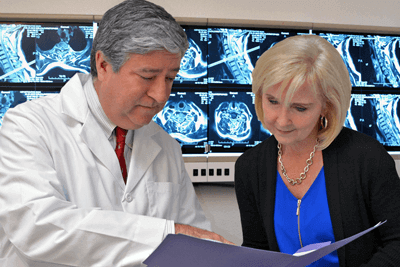Bulging Disc MRI
A bulging disc occurs when the disc swells outside the space it typically occupies between the vertebrae, but it does not rupture as with herniated discs. A bulging disc usually affects a larger section of the disc than a herniated disc. Moreover, while it is more common to have a bulging disc than a herniated disc, bulging discs sometimes appear without showing any symptoms or inflicting any pain.
Bulging discs usually develop through the natural aging process and the degeneration of the intervertebral disc. A bulging disc becomes symptomatic when it swells and presses on nerves or nerve roots. This is sometimes called segmental spinal stenosis. Injury of the vertebral disc and overuse or misuse of the discs can also weaken the discs and make them more prone to problems.
Bulging discs are relatively common, and in many cases, do not show any symptoms or cause discomfort. However, as the disc bulges out and presses on a nearby nerve, most people experience pain, numbness, and/or muscle weakness in that area, or along the affected nerve pathway. Depending on which area of the spine is affected, patients may bulging disc symptoms in cervical, thoracic or lumbar spine.
The treatment for a bulging disc depends on the symptoms. Many patients can manage their symptoms with pain medication, exercise, and physical therapy. The majority of people notice a significant difference over several weeks or in some cases months after conservative treatment. If symptoms worsen or they do not resolve with conservative treatment, surgery may be required to remove the bulging disc and decompress the nerves.
Who Is a Candidate for a Bulging Disc MRI?
A magnetic resonance imaging (MRI) examination for a bulging disc allows the physician to view the spine and determine if there is a bulging disc and in some cases find out what caused it. An MRI offers visual confirmation of the bulging disc, taking detailed images of any part of the body that make up the spinal column and the spinal discs in between the vertebrae.
When people experience chronic pain either on their back, legs, or arms, an MRI is usually recommended to pinpoint the course of pain and rule out any other diagnosis. If patients experience chronic leg or back pain, an MRI can help confirm a bulging disc diagnosis.
Before the MRI
An MRI is an important part of a bulging disc diagnosis. Before you undergo an MRI, a screening checklist is usually performed by the technician to disclose anything that might create a health hazard or interfere with imaging. Before an MRI, eat regularly and continue to take usual medications, unless otherwise instructed by a physician. Before an MRI scan, most people are asked to remove things that might interfere with the magnetic imaging such as:
- Jewelry
- Eyeglasses
- Dentures
- Hearing aids
- Hairpins
During the MRI
The MRI machine can be intimidating. During an MRI screening, you lie down on a movable table that slides through the machine while a technologist monitors the images from another room. The Bonati Spine Institute houses a state-of-the-art Magnetic Resonance Imaging (MRI) scanner at its imaging center. Our spacious wide-bore MRI system (the widest in the industry) provides a comfortable experience for our patients while producing the most detailed images with exceptional quality for our physicians to view. This superior image quality is a very important tool for our surgeons’ extensive pre-operative diagnosis.
The procedure is completely painless, however, during the scan, the inertial part of the machine produces repetitive tapping, thumping, and other noises that can upset the patient, which is why earplugs are provided to help block the noise.
In some cases, a contrast solution, usually gadolinium, may be administered through an intravenous line into a vein to enhance the appearance of certain details.
After the MRI
After the MRI test people can resume usual activities immediately unless they have been sedated. In general, there is no special care required after an MRI scan. The physician may provide additional instructions after the procedure, depending on the results.
If you think you may be suffering from a bulging disc or need your MRI reviewed, please contact us.
Check out the results of The Bonati Spine Procedures by clicking here.

